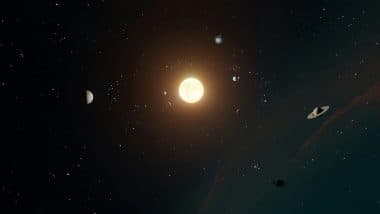January 2025 is shaping up to be an exciting and interesting month, especially for astronomers, stargazers, and nature lovers. The night skies are offering us a rare celestial phenomenon where seven planets will align in the sky. A planet parade or planetary alignment is not rare, but it does not occur every year, making this a special event. During the January 2025 planet parade, six planets—Jupiter, Mars, Uranus, Neptune, Venus, and Saturn—will create an arc in the night sky, and Mercury will make a brief appearance. The rare planetary alignment will peak on January 25, 2025; however, it will be visible on other days as well. January 2025 Planetary Alignment: Know Dates, Best Viewing Times, Visibility, Skywatching Tips and More Details of Planet Line Up.
What Is a Planet Parade?
A planet parade, also known as a planet line-up or planetary alignment, happens when four or more planets appear to align in the sky. However, in reality, the planets are actually millions of kilometres away from each other. The planets appear to be in alignment from our view point on Earth due to their position along the ecliptic plane.
Will All 7 Planets Be Visible in the Night Sky?
The January 2025 planet parade is already on display, and you can view the planets on a clear evening throughout this month. The planets Jupiter, Saturn, Mars, and Venus can be viewed even with the naked eye. To view Neptune and Uranus, you will need to use binoculars or a telescope. Viewing Mercury can be tricky due to the planet’s close proximity to the sun and its small size.
January 2025 Planet Parade Peak Dates
The peak dates for the January 2025 peak dates are from January 21 to February 21. The best night to view the planetary alignment will be between January 21 and January 29, on the new moon night.
How To View the Planetary Alignment?
Venus and Saturn will be visible in the west, while Jupiter and Mars will be visible in the east. Mercury will join the planet line-up briefly in the first week of March. Look to the west right after sunset on March 8 to view Mercury between Veus and Saturn before it drops below the horizon. The visibility of the planets will depend on the time of the day and their relative proximity at any time. For example, Jupiter, Venus, and Saturn can be seen after 07:00 PM local time, whereas Mars can be seen best at pre-dawn.
Planet Parade Misconceptions Explained
While the phenomenon is rare, there are many misconceptions that are floating around. According to many claims being made on social media, the January 2025 planetary alignment is extremely rare and a once-in-a-396-billion-years event. However, it is important to note that a planet line-up is not rare, though it does not occur every year. This is also not a once-in-a-396-billion-years event. This is not even the first or the last time a planetary alignment is happening. It has happened in the past, and more will occur in the future. There were claims of earthquakes and tidal waves being caused by the gravitational pull of the planets, but there is no science-backed proof of the claims. Planetary Alignment of January 25: Will 7 Planets Be Visible with the Naked Eye? Best Time to View the Planet Parade, Skywatching Tips and Other Details To Know.
To view the planet parade, ensure you travel to a place away from city lights and light pollution, like a rural area. Carry binoculars or a telescope with you to get the best view of the planets.
(The above story first appeared on LatestLY on Jan 20, 2025 03:45 PM IST. For more news and updates on politics, world, sports, entertainment and lifestyle, log on to our website latestly.com).













 Quickly
Quickly












